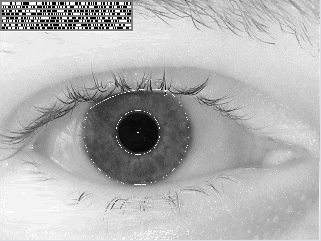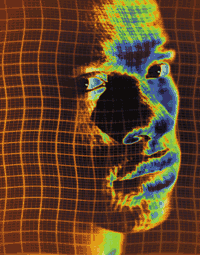.: Click here to download :.
Pattern recognition methods can be classified into
semantic and nonsemantic approaches. The use of the
Karhunen-Loeve Transform (KLT) for object recognition
and, in particular, face recognition, are examples of
nonsemantic techniques. The advantage of such methods
arises from the automatic generation of suitable feature
vectors by the KLT. Advanced feature extraction techniques
find extensive use in the increasingly important domain of
biometric identity authentication. As security becomes an
issue of importance, biometrics and iris recognition
in particular are attracting great interest. The human iris, a
thin circular diaphragm lying between the cornea and the
lens, has an intricate structure with many minute characteristics
such as furrows, freckles, crypts, and coronas. For
every subject, these characteristics are unique as a result of the
individual differences that arise in the development of
anatomical structures during embryonic development. Apart
from general textural appearance and color, the finely
detailed structure of an iris is not genetically determined but
develops by a random process. The iris patterns of the two
eyes of an individual or those of identical twins are
completely independent and uncorrelated. Additionally,
the iris is highly stable over a person’s lifetime and lends itself
to noninvasive identification because it is an externally visible
internal organ. Pioneering work on iris recognition was done by Daugman
using Gabor wavelets.
We have developed a method for iris
matching using zero crossings of a Discrete
Cosine Transform (DCT) as a means of feature extraction for
later classification. The DCT of a series of averaged overlapping
patches are taken from normalized iris
images and a small subset of coefficients is used to form
subfeature vectors. Iris codes are generated as a sequence of
many such subfeatures, and classification is carried out using
a weighted Hamming distance metric.
We have compared our results with a publicly available system for iris
recognition developed by Libor Masek and Peter Kovesi available here.
Our code has been tested with CASIA Iris Database achieving an excellent
recognition rate of 98.843% (108 classes, 3 training images and
4 test images for each class, hence there are 324 training images and 432 test images
with no overlap between the training and test images). On the same
training and testing set Libor Masek's algorithm can reach a recognition
rate of 97.917%.
Libor Masek, Peter Kovesi. MATLAB Source Code for a Biometric Identification System Based on Iris Patterns.
The School of Computer Science and Software Engineering, The University of Western Australia, 2003.
Index Terms: Matlab, source, code, iris, recognition, dct, discrete cosine transform, Karhunen-Loeve Transform, KLT.
 |
Figure 1. Iris code |
||||||||||||||
|
A simple and effective source code for DCT-Based Iris Recognition. |
|||||||||||||||
Demo code (protected
P-files) available for performance evaluation. Matlab Image Processing Toolbox and Matlab Signal Processing Toolbox are required. |
|||||||||||||||
|
Release |
Date |
Major features |
|||||||||||||
|
1.0 |
2024.11.18 |
|
|||||||||||||
We recommend to check the secure connection to PayPal, in order to avoid any fraud. This donation has to be considered an encouragement to improve the code itself. |
|||||||||||||||
DCT-Based Iris Recognition - Click here for
your donation. In order to obtain the source code you
have to pay a little sum of money: 350 EUROS (less
than 490 U.S. Dollars). |
|||||||||||||||
Once you have done this, please email us [email protected] As soon as possible (in a few days) you will receive our new release of DCT-Based Iris Recognition. Alternatively, you can bestow using our banking coordinates:
|
|||||||||||||||
The authors have no relationship or partnership
with The Mathworks. All the code provided is written in Matlab
language (M-files and/or M-functions), with no dll or other
protected parts of code (P-files or executables). The code was
developed with Matlab 2006a. Matlab Image Processing Toolbox and Matlab Signal Processing Toolbox are required.
The code provided has to be considered "as is" and it is without any kind of warranty. The
authors deny any kind of warranty concerning the code as well
as any kind of responsibility for problems and damages which may
be caused by the use of the code itself including all parts of
the source code.

